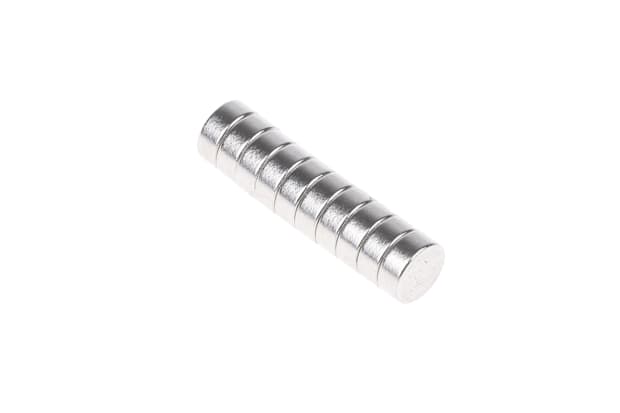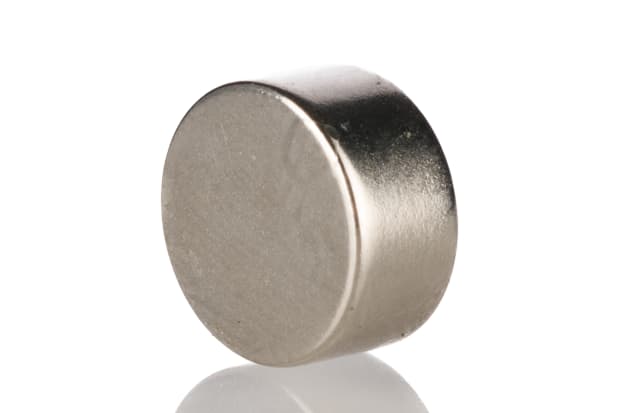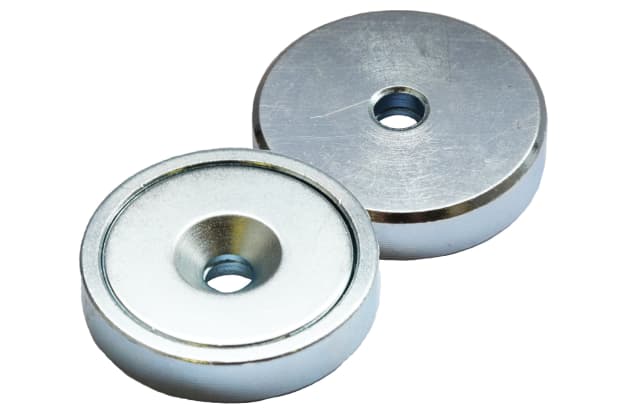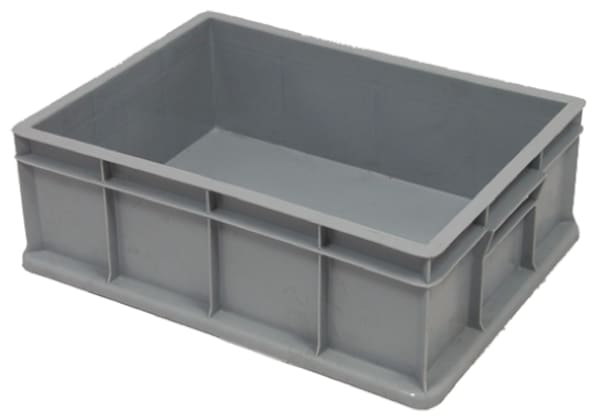- Published 12 Jan 2023
- Last Modified 29 Aug 2023
- 5 min
A Complete Guide to Neodymium Magnets
Learn everything you need to know about neodymium magnets and see some of the best products available in our guide.

Reviewed by Osman Hafeji, Technical Support Engineer (March 2021)
Neodymium magnets are permanent magnets (i.e. they generate their own magnetic field) made from an alloy of the metallic elements neodymium, iron and boron.
Neodymium magnets in the UK are the strongest commercially available magnets, meaning that they can lift objects many times their weight. They are widely used as positioning, pulling and clamping components in sectors such as engineering, manufacturing, education, research and industry.
These magnets are sometimes also referred to as rare earth neodymium magnets or rare earth magnets. This is because neodymium is a rare earth metal, a subset of seventeen chemically similar elements. However, the latter term should be used with caution in this context as it can also refer to more specialist magnets made from a different rare earth mineral called samarium.

Neodymium is a chemical element with the atomic number 60. Neodymium is also known as neo, NIB, or NdFeB, a name derived from the chemical symbols for each of the three constituent elements.
Neodymium Magnet Strength
Neo magnets are the strongest commercially available magnets. Their pull force is typically over ten times that of more familiar ceramic (ferrite) magnets.
These powerful magnets combine high coercivity with a high maximum energy product. In other words, they produce a dense magnetic field that will resist decay.
Magnets' Power and the Manufacturing Process
There are two principal ways that neodymium magnets can be made - sintering or bonding. Each refers to a different manufacturing process, as detailed below:
- Sintering is the process of pressure forming the raw magnetic materials into blocks before putting them through an intricate heating process. The block will then be cut into the required shape and coated for increased corrosion resistance
- Bonding involves the creation of magnets by mixing raw materials and binding with epoxy, before being pressed into a die cavity and heat cured
Strong neodymium magnets are usually manufactured by sintering because sintered types are typically about double the strength of their bonded counterparts. Conversely, bonded NIB magnets are typically more versatile and affordable. This is because bonded neodymium magnets can be formed into a wide range of different sizes and shapes as required, whereas sintered magnets are confined to comparatively simple shapes as they can be quite brittle.
Neodymium Magnet Grades
Sintered NdFeB magnets are ranked by their maximum energy product (MGOe), a number that ranges from N30 to N52. This figure, in a unit of measurement called megagauss-oersteds, indicates the level of stored energy in the magnet. Magnets with higher N grades will typically be more brittle than those with lower numbers. The proceeding ‘N’ refers to neodymium and some magnet grades also feature suffixed letters indicating the coercivity.
Common grades include neodymium magnets N52, N50, N48, N45, N42 and N35.
Buy Neodymium Magnets
Buy neodymium magnets for sale in the UK with RS. Browse a wide range of types, grades and sizes, giving you the freedom you need to select the most suitable magnet for your requirements. Our neodymium magnet prices start from just 60p per magnet (when purchased in bulk) and include a wide range of affordable options for every project.
Products & Prices
0.55kg Magnets
Eclipse Neodymium Magnet 0.55kg, Length 2mm, Width 5mm. Price one bag of ten £5.60 (exc. VAT)
2.5kg Magnets
Eclipse Neodymium Magnet 2.5kg, Width 10mm. Price one box of ten £24.88 (exc. VAT)
3.3kg Magnets
Eclipse Neodymium Magnet 3.3kg, Width 15.4mm. Price one bag of five £12.31 (exc. VAT)
10.5kg Magnets
Eclipse Neodymium Magnet 10.5kg, Length 6mm, Width 20mm. Price one pair £10.81 (exc. VAT)
Shapes, Sizes and Properties of Neodymium Magnets
Neodymium magnets are produced in a variety of specifications, sizes and versatile designs for different applications.
Some of the most common shapes include:
- Neodymium magnet balls
- Neodymium ring magnets
- Neodymium magnet cubes
- Neodymium rectangular magnets
Other shapes include discs, bars, blocks and pots. Both counterbore and countersink varieties are widely available.
As these magnets are so powerful, smaller sizes are usually sufficient for many applications. However, large neodymium magnets are also available for specialist tasks.
When measuring sizes, you should consider:
- The diameter, width and length
- Its thickness
- The thread size
Physical and Mechanical Properties
In comparison to other types of permanent magnet, NdFeB has:
- A stronger magnetic field: a property called remanence
- Much greater resistance to demagnetisation: a quality called coercivity
- A denser magnetic field: technically termed a high maximum energy product or level of saturation magnetisation. This provides these magnets with significant pulling power
- Lower resistance to high temperatures, which will induce demagnetisation. The temperature at which a magnet will demagnetise is called its Curie temperature
Neodymium Magnet Uses
Neodymium is versatile and can be used for a multitude of different tasks. Due to its high-strength, high-performance magnetic properties, it is primarily used for more demanding and heavy-duty commercial and industrial applications.
Typical uses could include:
- Attracting, clamping and positioning
- Fixing, lifting and closure
- Screw fixing
Neodymium disc or ring magnets are often used for positioning, fastening and fixing components as the threaded hole in the ring allows secure mating. This is ideal in scenarios where one electrical component needs to be securely attached to another.
FAQs
Do Neodymium Magnets Wear Out?
NdFeB magnets are sensitive to high temperatures and will lose their charge if exposed to these for a significant period. They have a comparatively low Curie temperature - approximately 80℃. However, without exposure to high temperatures, neodymium magnets will retain their charge for a very long time, losing as little as 5% every 100 years.
How Long Do Neodymium Magnets Last?
In optimal conditions, without excessive exposure to high temperatures or corrosive environments, neodymium magnets will retain most of their magnetic charge for hundreds of years.
Can You Grind Neodymium Magnets?
No. Neodymium is a hard, brittle substance with a texture like glass. It will chip and break if grinding is attempted.
Can You Drill a Hole in a Neodymium Magnet?
No. Drilling will produce potentially hazardous dust and raise the magnet's temperature which could encourage demagnetisation. It will also remove the anticorrosive coating from the drilled area. Neodymium ring magnets are a handy solution to this as they already have a central hole for easy use.
Do Neodymium Magnets Resist Corrosion?
Sintered NdFeB magnets are vulnerable to corrosion, with graining along the metals especially prone to erosion. At its worst, corrosion can induce serious powdering or fragmentation of the entire magnet. To address this, most commercial neodymium magnets feature a protective outer coating for resistance to atmospheric wear. This is typically made from nickel, a copper-nickel alloy, polymer or lacquer.
How Do You Store Neodymium Magnets?
As they are sensitive to both high temperatures and corrosion, neodymium magnets should be stored in a mild environment with low humidity. To minimise the accumulation of atmospheric particles on either the magnets themselves or their outer packaging, it is recommended to store them in closed, dust-free containers, within the original manufacturer’s wrapping if possible.





